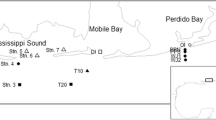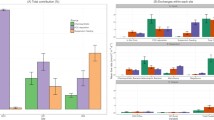Abstract
Geomorphic, stratigraphic, and faunal observations of submarine slide scars that occur along the flanks of Monterey Canyon in 2.0–2.5 km water depths were made to identify the processes that continue to alter the surface of a submarine landslide scar after the initial slope failure. Deep-sea chemosynthetic biological communities and small caves are common on the sediment-free surfaces of the slide scars, especially along the headwall. The chemosynthetic organisms observed on slide scars in Monterey Canyon undergo a faunal succession based in part on their ability to maintain their access to the redox boundaries in the sediment on which they depend on as an energy source. By burrowing into the seafloor, these organisms are able to follow the retreating redox boundaries as geochemical re-equilibration occurs on the sole of the slide. As these organisms dig into the seafloor on the footwall, they often generate small caves and weaken the remaining seafloor. While chemosynthetic biological communities are typically used as indicators of fluid flow, these communities may be supported by methane and hydrogen sulfide that are diffusing out of the fresh seafloor exposed at the sole of the slide by the slope failure event. If so, these chemosynthetic biological communities may simply mark sites of recent seafloor exhumation, and are not reliable fluid seepage indicators.






Similar content being viewed by others
References
Barry JP, Kochevar RE (1998) A tale of two clams: differing chemosynthetic life styles among vesicomyids in Monterey Bay cold seeps. Cah Biol Mar 39:329–332
Barry JP, Greene HG, Orange DL, Baxter CH, Robinson BH, Kochevar RE, Nybakken JW, Reed DL, McHugh CM (1996) Biologic and geologic characteristics of cold seeps in Monterey Bay, California. Deep-Sea Res I 43(11–12):1739–1762
Borowski WS, Paull CK, Ussler W III (1999) Global and local variations of interstitial sulfate gradients in deep-water, continental margin sediments: sensitivity to underlying gas hydrates. Mar Geol 159:131–154
Claypool GE, Kaplan IR (1974) Methane in marine sediments. In: Kaplan IR (ed) Natural gases in marine sediments. Plenum Press, New York, pp 99–139
Corliss JB, Dymond J, Gordon LI, Edmond JM, Von Herzen RP, Ballard RD, Green K, Williams D, Bainbridge A, Crane K, Van Andel TH (1979) Submarine thermal springs on the Galapagos Rift. Science 203:1073–1083
Crank J (1975) The mathematics of diffusion. Clarendon Press, Oxford
Dickens GR (2001) Sulfate and barium fronts in sediments on the Blake Ridge: present and past methane fluxes through a large gas hydrate reservoir. Geochim Cosmochim Acta 65:529–543
Fisher CR, Urcuyo IA, Simpkins MA, Nix E (1997) Life in the slow lane: growth and longevity of cold-seep vestimentiferans. Mar Ecol 18:83–94
Freytag JK, Girgus PR, Bergquisht DC, Andras JP, Childress JJ, Fisher CR (2001) A paradox resolved: sulfide acquisition by roots of seep tubeworms sustains net chemoautrophy. PNAS 98:13,408–13,413
Greene HG, Clark JC (1979) Neogene paleogeography of the Monterey Bay area, California. In: Cole MR, TerBest H, Armentrout J (eds) Cenozoic paleogeography of the western United States. Pacific Coast Symp 3, Pacific Section, Society of Economic Paleontologist and Mineralogists, pp 277–296
Greene HG, Maher NM, Paull CK (2002) Physiography of the Monterey Bay National Marine Sanctuary and implications about continental margin development. Mar Geol 181:55–82
Hampton MA, Lee HJ, Locat J (1996) Submarine landslides. Rev Geophys 34:33–59
Hensen C, Zabel M, Pfeifer K, Schwenk T, Kasten S, Riedinger N, Schulz HD, Boettius A (2003) Control of sulfate pore-water profiles by sedimentary events and the significance of anaerobic oxidation of methane for the burial of sulfur in marine sediments. Geochim Cosmochim Acta 67:2631–2647
Hovland M, Judd AG (1988) Seabed pockmarks and seepages. Graham and Trotman, London
Jullian D, Gaill F, Wood E, Arp AJ, Fisher CR (1999) Roots as a site of hydrogen sulfide uptake in the hydrocarbon seep vestimentiferan Lamellibrachia sp. J Exp Biol 202:2245–2257
Lerman A (1979) Geochemical processes: water and sediment environments. Wiley, New York
Li Y, Gregory S (1974) Diffusion of ions in sea water and in deep sea sediments. Geochim Cosmochim Acta 38:703–714
Lutz RA, Fritz LW, Rhoads DC (1985) Molluscan growth at deep-sea hydrothermal vents. Bull Biol Soc Washington 6:199–210
Mayer LA, Shor AN, Hughes Clarke J, Piper DJW (1988) Dense biological communities at 3850 m on the Laurentian Fan and their relationship to the deposits of the 1929 Grand Bank earthquake. Deep-Sea Res A 35:1235–1246
McHatton SC, Barry JP, Jannasch HW, Nelson DC (1996) High nitrate concentrations in vacuolate, autotrophic marine Beggiatoa spp. Appl Environ Microbiol 62:54–958
Naehr TH, Stakes DS, Moore WS (2000) Mass wasting, ephemeral fluid flow, and barite deposition on the California continental margin. Geology 28:315–318
Neumann AC (1966) Observations on coastal erosion in Bermuda and measurements on the boring rates of the sponge Cliona lampa. Limnol Oceanogr 11:92–108
Orange DL, Greene HG, Reed D, Martin JB, McHugh CM, Ryan WBF, Maher N, Stakes DS, Barry J (1999) Widespread fluid expulsion on a translational continental margin; mud volcanoes, fault zones, headless canyons, and organic-rich substrate in Monterey Bay, California. Geol Soc Am Bull 111:992–1009
Orphan VJ, House, CH, Hinrichs K-U, McKeegan KD, DeLong EF (2001) Methane-consuming archaea revealed by directly coupled isotopic and phylogenetic analysis. Science 293:484–487
Paull CK, Hecker B, Neumann AC, Sikes EL, Hook J, Corso W, Freeman-Lynde R, Commeau R, Golubic S, Curray J (1984) Biological communities at the Florida Escarpment resemble hydrothermal vent taxa. Science 226:965–967
Paull CK, Ussler III W, Maher N, Greene HG, Rehder G, Lorenson T, Lee H (2002) Pockmarks off Big Sur, California. Mar Geol 181:325–335
Reeburgh WS (1976) Methane consumption in the Cariaco Trench waters and sediments. Earth Planet Sci Lett 28:337–344
Roberts ML, Bench GS, Brown TA, Caffee MW, Finkel RC, Freeman SPHT, Hainsworth LJ, Kashgarian M, McAninch, Proctor ID, Sothon JR, Vogel JS (1997) The LLNL AMS Facility. Nuclear Instrum Meth Phys Res B123:57–61
Sibuet M, Olu K (1998) Biogeography, biodiversity and fluid dependence of deep-sea cold-seep communities at active and passive margins. Deep-Sea Res II 45:517–567
Summerhayes CP, Bornhold BD, Embley RW (1979) Surficial slides and slumps on the continental slope and rise of South West Africa: a reconnaissance study. Mar Geol 31:265–277
Tappin DR, Watts P, McMurtry GM, Lafoy Y, Matsumoto T (2001) The Sissano, Papua New Guinea tsunami of July 1998; offshore evidence on the source mechanism. Mar Geol 175:1–23
Warme JE, Slater RA, Cooper RA (1978) Bioerosion in submarine canyons. In: Stanley DJ, Kelling G (eds) Sedimentation in submarine canyons, fans, and trenches. Dowden, Hutchinson & Ross, Stroudsburg, Pennsylvania, pp 65–69
Acknowledgements
The David and Lucile Packard Foundation provided support. The crew of the R/V Western Flyer and the ROV pilots deserve special thanks for their continued excellence in providing access to the seafloor.
Author information
Authors and Affiliations
Corresponding author
Rights and permissions
About this article
Cite this article
Paull, C.K., Ussler, W., Greene, H.G. et al. Bioerosion by chemosynthetic biological communities on Holocene submarine slide scars. Geo-Mar Lett 25, 11–19 (2005). https://doi.org/10.1007/s00367-004-0184-z
Received:
Accepted:
Published:
Issue Date:
DOI: https://doi.org/10.1007/s00367-004-0184-z




